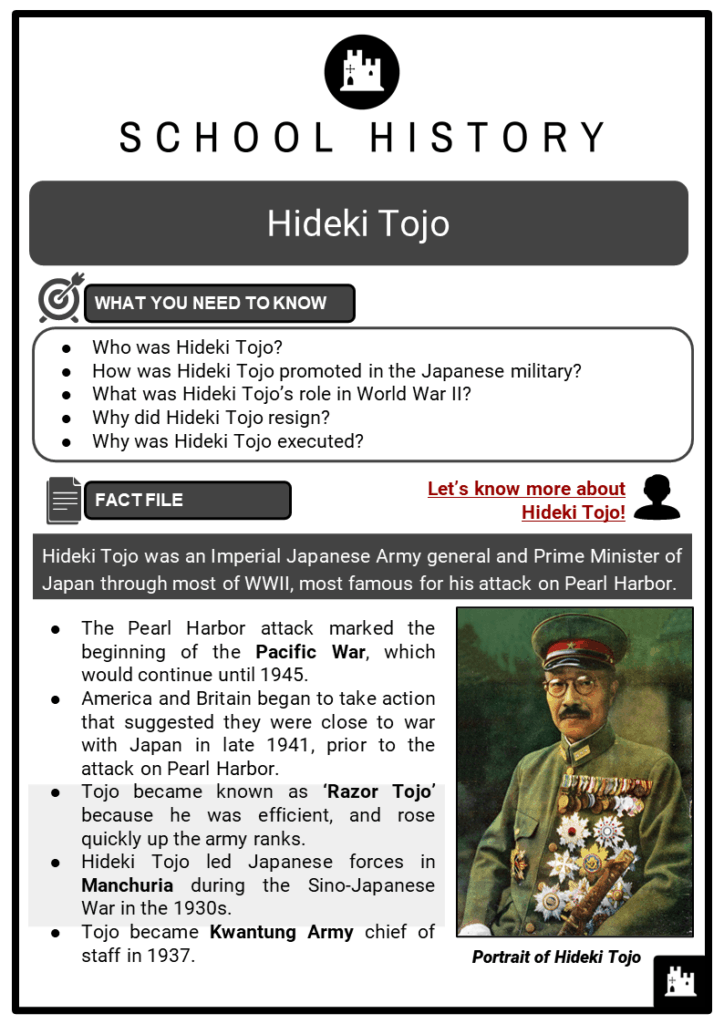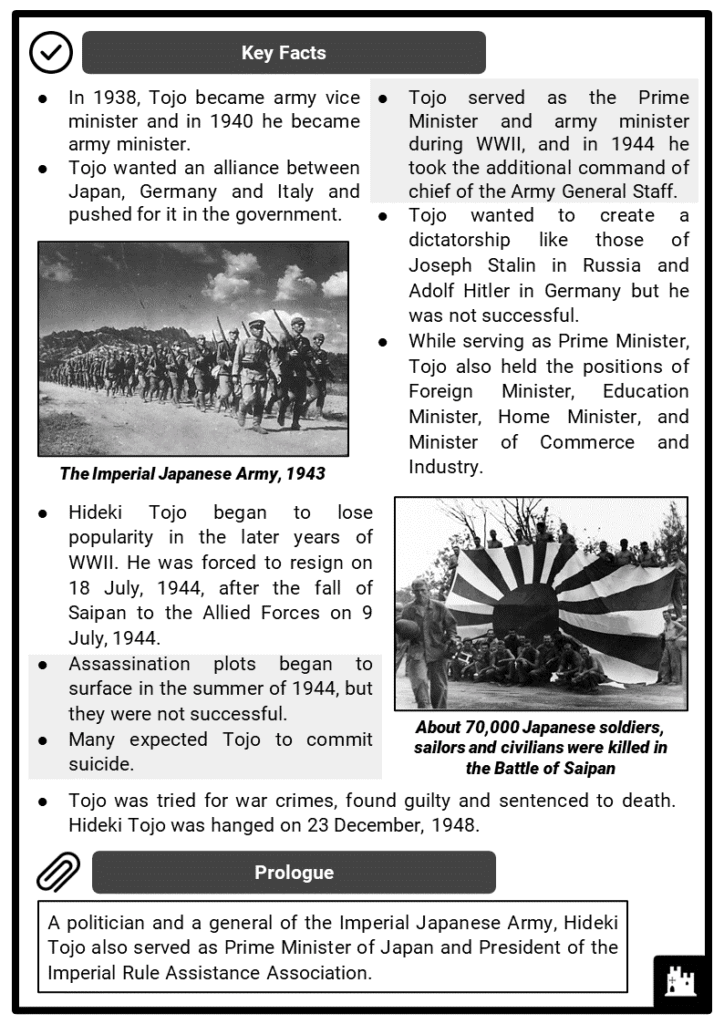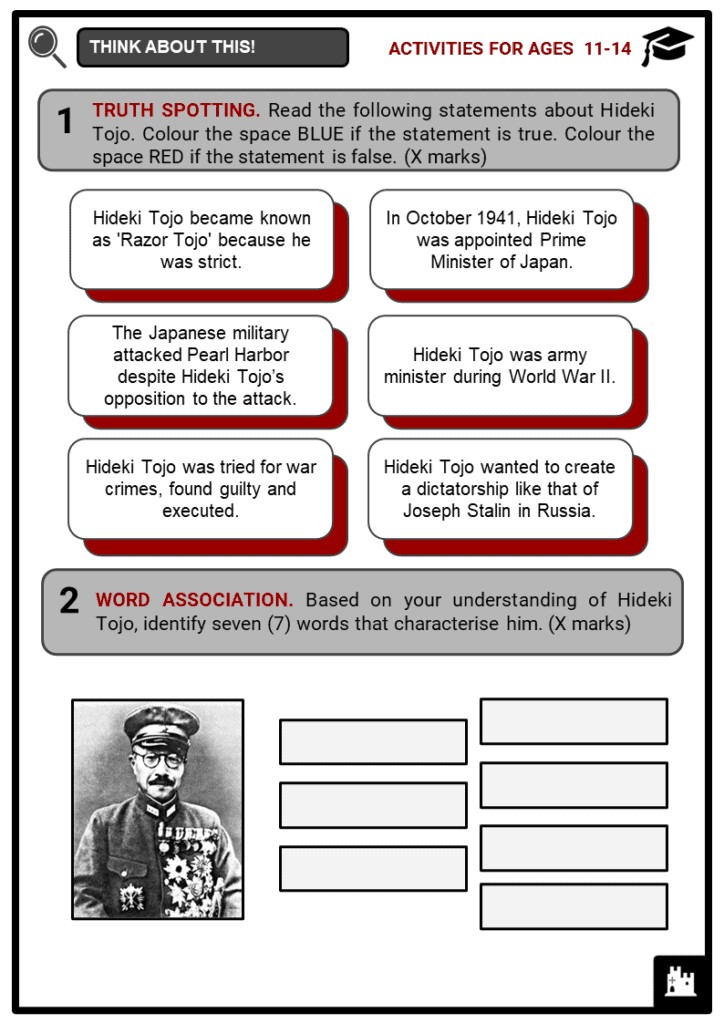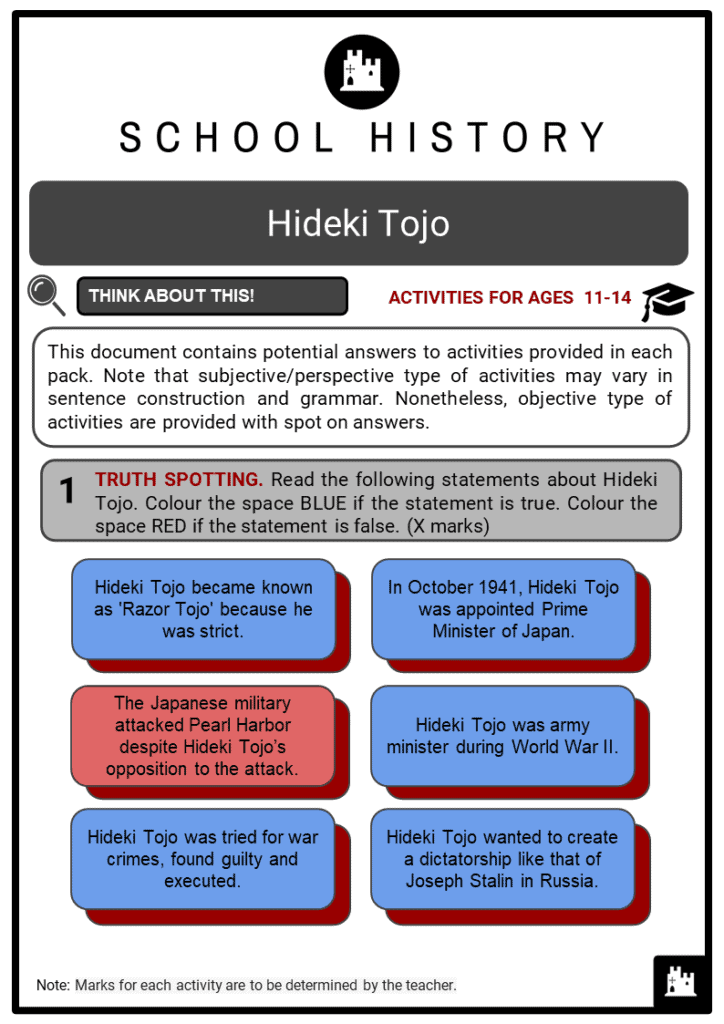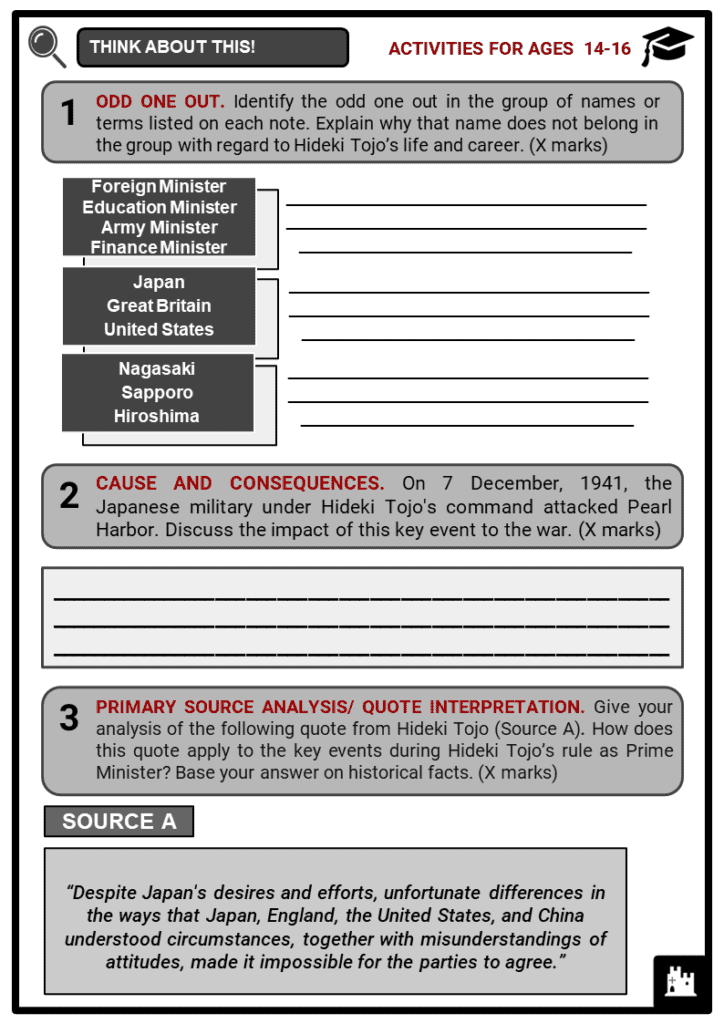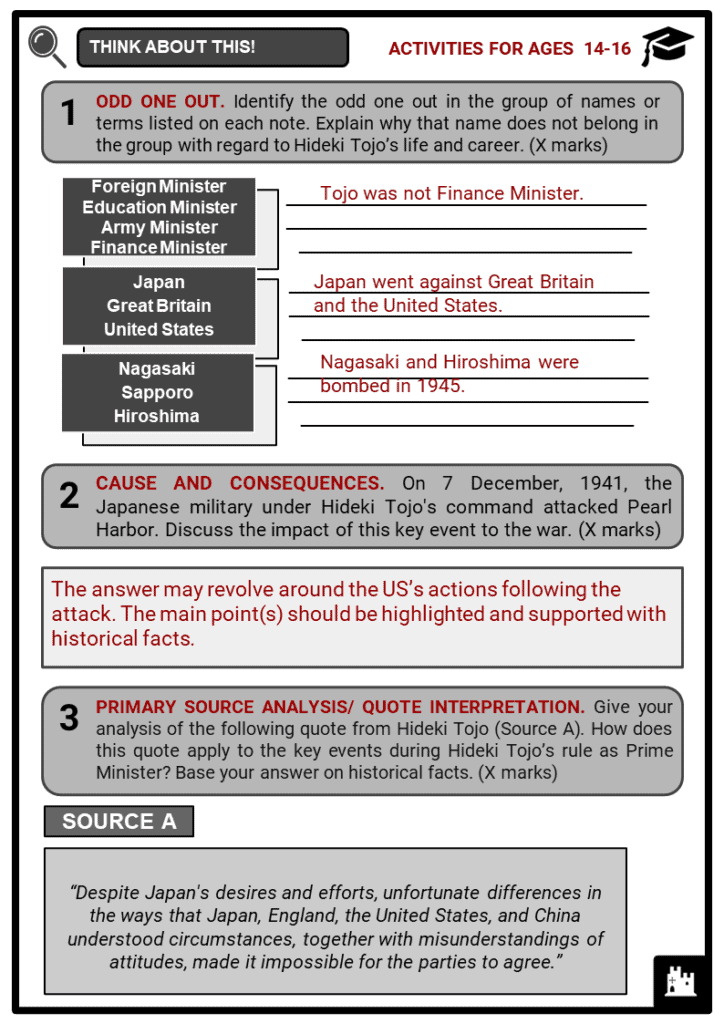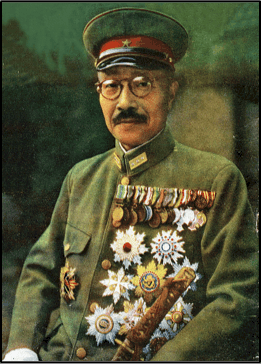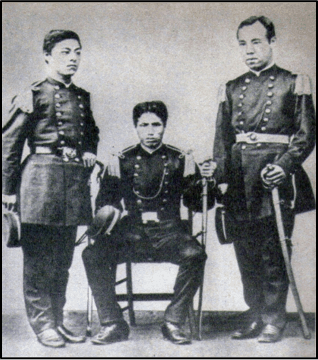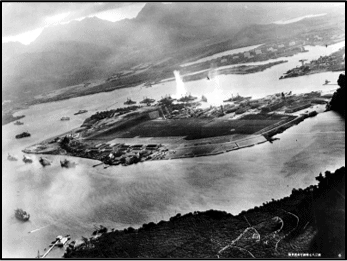Download Hideki Tojo Worksheets
Do you want to save dozens of hours in time? Get your evenings and weekends back? Be able to teach Hideki Tojo to your students?
Our worksheet bundle includes a fact file and printable worksheets and student activities. Perfect for both the classroom and homeschooling!
Table of Contents
Add a header to begin generating the table of contents
Summary
- Who was Hideki Tojo?
- How was Hideki Tojo promoted in the Japanese military?
- What was Hideki Tojo’s role in World War II?
- Why did Hideki Tojo resign?
- Why was Hideki Tojo executed?
Key Facts And Information
Let’s know more about Hideki Tojo!
- Hideki Tojo was an Imperial Japanese Army general and Prime Minister of Japan through most of WWII, most famous for his attack on Pearl Harbor.
- The Pearl Harbor attack marked the beginning of the Pacific War, which would continue until 1945.
- America and Britain began to take action that suggested they were close to war with Japan in late 1941, prior to the attack on Pearl Harbor.
- Tojo became known as ‘Razor Tojo’ because he was efficient, and rose quickly up the army ranks.
- Hideki Tojo led Japanese forces in Manchuria during the Sino-Japanese War in the 1930s.
- Tojo became Kwantung Army chief of staff in 1937.
Key Facts
- In 1938, Tojo became army vice minister and in 1940 he became army minister.
- Tojo wanted an alliance between Japan, Germany and Italy and pushed for it in the government.
- Tojo served as the Prime Minister and army minister during WWII, and in 1944 he took the additional command of chief of the Army General Staff.
- Tojo wanted to create a dictatorship like those of Joseph Stalin in Russia and Adolf Hitler in Germany but he was not successful.
- While serving as Prime Minister, Tojo also held the positions of Foreign Minister, Education Minister, Home Minister, and Minister of Commerce and Industry.
- Hideki Tojo began to lose popularity in the later years of WWII. He was forced to resign on 18 July, 1944, after the fall of Saipan to the Allied Forces on 9 July, 1944.
- Assassination plots began to surface in the summer of 1944, but they were not successful.
- Many expected Tojo to commit suicide.
- Tojo was tried for war crimes, found guilty and sentenced to death. Hideki Tojo was hanged on 23 December, 1948.
Prologue
- A politician and a general of the Imperial Japanese Army, Hideki Tojo also served as Prime Minister of Japan and President of the Imperial Rule Assistance Association.
- Tojo’s voice was among the loudest concerning the preventive war against the United States during deliberations leading up to Pearl Harbor. Upon becoming Prime Minister, he presided over much of the conquest of the West’s territories in Asia and the Pacific until the defeat of Japanese forces at Midway and Guadalcanal.
- His years in power gave him the tools for perpetuating numerous war crimes including the systematic massacre and starvation of civilians and prisoners of war. But the war’s tide increasingly turned against Japan, leading to Tojo’s late resignation as Prime Minister. Japan’s surrender was inevitable, soon after Tojo was sentenced to death by the International Military Tribunal for the Far East. He was hanged on 23 December 1948.
Hideki Tojo
- Born in the Kojimachi district of Tokyo on 30 December, 1884, Tojo was the third son of Hidenori Tojo, a lieutenant general in the Imperial Japanese Army.
- In this period, Japanese society was divided into four castes: Merchants, Artisans, Peasants and Samurai. After the Meiji Restoration in 1868, the caste system was slowly abolished, ending in 1871 but the distinctions remained and persisted. This somehow ensured the former Samurai caste’s traditional prestige. Tojo’s family came from such a caste, though they were relatively low warriors for the great daimyos.
- His father was turned from samurai to army officer while his mother was the daughter of a Buddhist priest, making the family respectable, but poor.
- The typical education for a Japanese youth in the Meiji era, including Tojo’s, was the purpose of training boys to be soldiers as adults. This message was relentlessly drilled into Japanese students.
- They made the generation believe that war was the most beautiful thing, that the Emperor was a living god and that the greatest honour was to die for him. The girls were taught that the highest honour for a woman was to have many sons so that they could die for the Emperor.
- The schools in the Meiji era were very competitive, and there was no tradition of sympathy for failure. Failure was not tolerated and even the teachers would bully those who failed. Tojo didn’t stand out with his grades in school, however he was known for his willingness to work extremely hard. One of his heroes was the shogun Tokugawa who issued the injunction: “Avoid the things you like, turn your attention to unpleasant duties.”
- He followed in his father’s footsteps and graduated from the Japanese Military Academy. In 1905 he was commissioned as a second lieutenant in the infantry and was outraged upon hearing of the Treaty of Portsmouth which ended the war with Russia and thus did not end with Japan’s annexation of Siberia.
- The Treaty of Portsmouth can be considered the start of anti-American sentiments among the Japanese though they did not know that this war almost bankrupt their country. They saw the treaty as unfair for Japan’s rightful gains.
- In 1909, Tojo married and had three sons and 1918 went to serve in Siberia as part of the Japanese expeditionary force to intervene in the Russian Civil War. He also served as military attaché to Germany until 1922. The Japanese were very influenced by the intellectual developments of Germany and often imitated them in a sense. Also in 1922, Tojo took a train ride across the United States, his first and last visit. From his travels he deduced that the Americans were very materialistic, soft and devoted to money-making and other hedonistic pursuits.
- In 1924, the Immigration Control Act was passed by the American Congress which banned all Asian immigration to the United States. The reason for this was that Asians worked harder than whites, a statement issued openly by Congressmen and Senators.
- This was very offensive to the Japanese and Tojo wrote that American whites would never accept Asians as equals and that the act showed that they put their own interests first.
Ascension
- By 1928, Tojo was already bureau chief of the Japanese Army and shortly after, colonel. He would often visit his men’s homes and assisted them with their personal problems and made loans to officers who were short on money.
- By 1934 he was promoted to major general and served as Chief of the Personnel Department within the army ministry.
- Following the Japanese invasion of Manchuria in 1931, Tojo wrote a chapter in
- the book “Essays in time of national emergency”.
- He called for Japan to become totalitarian in order to prepare for the next war.
- He attacked Britain, France and the United States for waging “ideological war” against Japan since 1919.
- Politically, he was a nationalist and militarist, and was nicknamed “Razor” for his reputation as a strict by-the-book mentality as well as his cold-bloodedness.
Tesions
- The relations between Japan and China reached a crisis point. In 1937, a skirmish at Beijing’s Marco Polo Bridge, called the “China Incident”, started the Second Sino-Japanese War over Western objections.
- Japan successfully captured the Chinese capital Nanking. The army proceeded to systematically rape and kills its people for six weeks in what is known as the Rape of Nanking. Economic sanctions were imposed on Japan by the United States in order to cripple it, but it had a different effect.
- The sanctions emboldened Japan to align against the US. Japan signed the Tripartite Pact with Germany and Italy in September 1940.
- Japanese soldiers marched into Southeast Asia to secure strategic resources and France’s Vichy regime allowed Japan to stage troops in northern Indochina aka Vietnam. This led to China’s complete locking, preventing the import of arms and good through its southern neighbours.
- By this time Tojo was appointed Army Minister in the second Fumimaro Konoe regime. Prince Konoe had chosen Tojo to secure his armies backing with foreign policy. Konoe favoured Germany in mediating an end to the Sino-Japanese War.
- Tojo was a supporter of the Tripartite Pact and continued to expand the war with China. He declared that any withdrawal from Indochina would make them seem weak.
- They were, however, unsure whether to wage war or pursue diplomatic negotiations in order to regain gasoline supplies.
- In October, Konoe was politically isolated and resigned, with Tojo later assuming the command. In November, Emperor Hirohito received the plans for the attack on Pearl Harbor, and later approved the war with the West.
- The Hull note was proposed to the Japanese by the American Secretary of State Cordell Hull, in which he proposed to Japan to withdraw all military forces from China and Indochina in exchange for the lifting of the oil embargo. However, some inconsistencies remained. Tojo chose to misinterpret the Hull Note as an ultimatum thus the war with the United States began.
World War II
- It was now publicly announced that Japan would go to war with the United States, the British Empire and the Netherlands. Tojo continued to hold his position as Prime Minister while also concurrently serving as the minister of Home, Foreign, Education, Commerce and Industry.
- Emperor Hirohito was advised by Konoe to choose Prince Naruhiko as Prime Minister, however he chose Tojo. Under Tojo’s and his cabinet’s advice, Hirohito consented to the Pearl Harbor attack and carried it out on 7 December leading to the official war with the United States and the British Empire.
- Initially, the Japanese were overjoyed by their victory after victory experience. This greatly increased Tojo’s popularity and made him solidify his power in 1942, by holding a special election to fill Japan’s legislature with his pro-war supporters. Difficulties lay with the Japanese army, however. Throughout the war, Tojo was hamstrung by the ineffective bureaucracy and infighting among the armed forces.
- While trying to consolidate power in his hands, he would be often criticised by people telling him that Germany’s errors in the war were due to Hitler’s micromanagement. Tojo reportedly said, “Hitler was an enlisting man. I am a general.” Allied propaganda portrayed him as an equivalent to Hitler and Mussolini. His image became the poster for all of Japan’s militarism and it was widely thought that he was solely responsible for all the atrocities and warmongering. Although one cannot blame one man
for these actions, some of Tojo’s actions were indeed atrocious. - The death rate of Western prisoners in Japan, for example, was seven times higher than the ones in Germany. Biological experiments were consented upon the prisoners and Tojo also approved the forced prostitution of so-called ‘comfort girls’. On the other hand, Tojo did approve the resettlement of Russian-Jewish refugees into Manchuria, despite German protestations.
The fall of Tojo Hideki
- Japan’s success in the war would soon come to an end. After the battle of Midway in June 1942, the tide turned to the American’s advantage and thus Tojo’s popularity rapidly declined. The Japanese were pushed back from all their conquered territories and confidence in the Prime Minister slipped even further. It became clear to many Japanese in positions of power that
- Japan lost the war. They forced Tojo to resign due to the fact that he was in no position to negotiate a peace treaty or ensure the survival of Japan.
- Tojo resigned on 18 July, 1944 after the Japanese suffered defeat at Saipan. Japan’s unconditional surrender was announced by Emperor Hirohito on 15 August, 1945, but it was formalised on 2 September.
- A week later, General Douglas MacArthur ordered the arrest of Tojo, who had gone into seclusion. He was easy to find but he did not submit and decided to kill himself. However, this failed as he missed his heart. He was nursed back in a military hospital and then
the trial arrived. - Branded as a class-A war criminal, Tojo was accused of murdering, ill-treating prisoners of war, imposing labour on civilians, destroying cities beyond justification, mass murder, pillage, torture and many other things upon the civilian population of the overrun countries. In a sense, Tojo achieved what he wished for. That is to die for his Emperor while taking all the blame of the war. He was sentenced to die on 12 November, 1948, and was hanged six weeks later.
Aftermath
- The work done by General MacArthur was heavily criticised by the historians Herbert P. Bix and John W. Dower, who stated that MacArthur and his staff exonerated Emperor Hirohito and all the other members of the imperial family. According to them, MacArthur worked to protect the Emperor and shift ultimate responsibility onto Tojo. Tojo was survived by his descendants who would go on and pursue military or media careers. In the movie Pride, Tojo is portrayed as a national hero, forced against his will by the Hull Note into attacking America and executed after a rigged trial, a picture of Tojo that is widely accepted in Japan while causing offence abroad.
Image sources:

